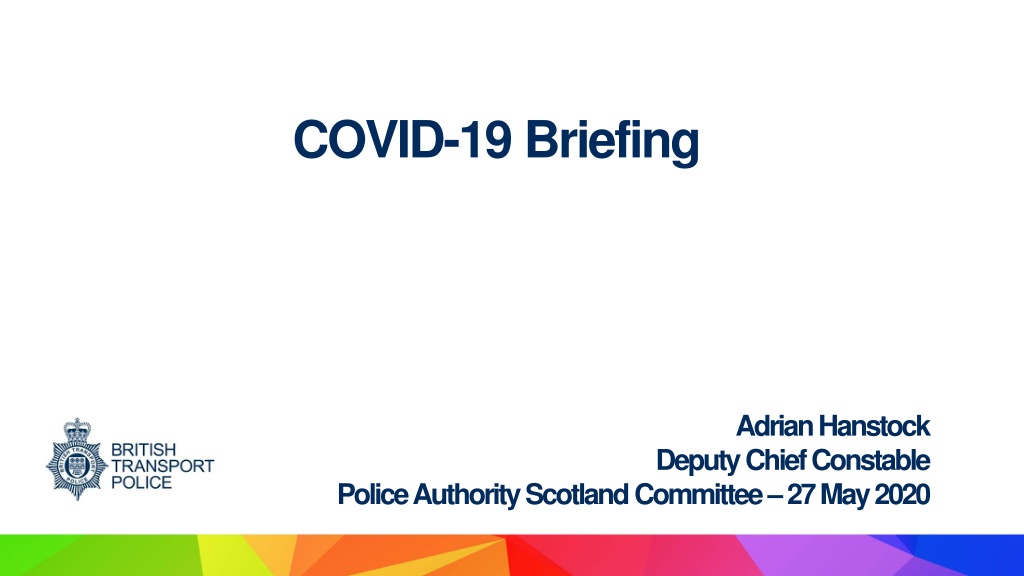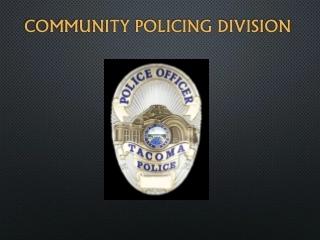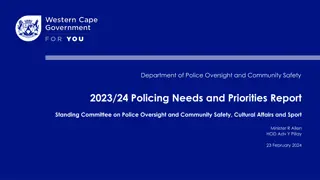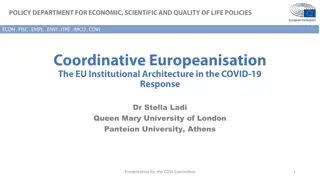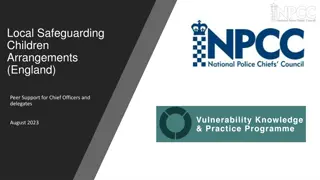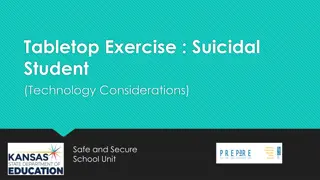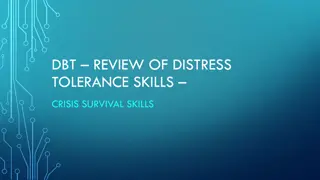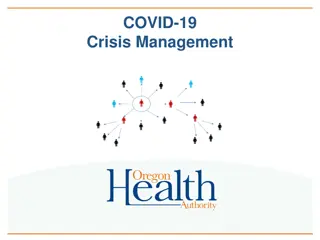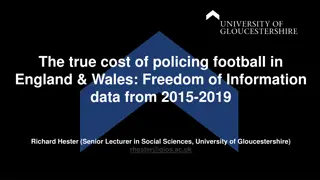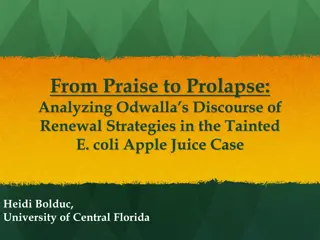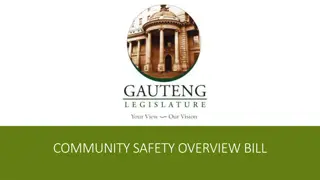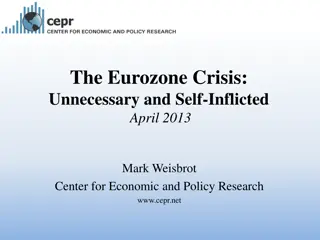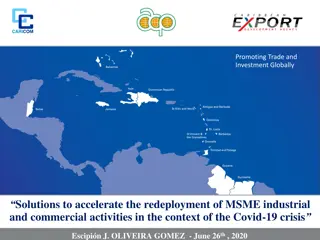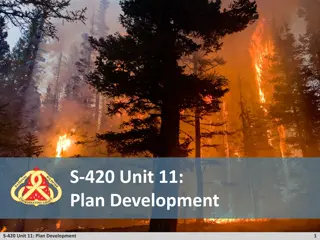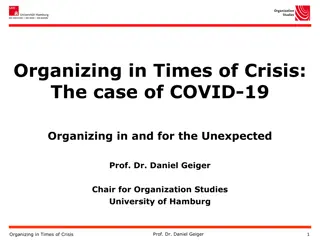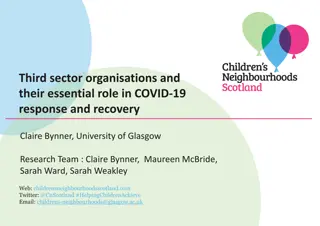Policing Response and Tactics during COVID-19 Crisis by BTP in Scotland
The British Transport Police (BTP) in Scotland have implemented a robust policing strategy under a Gold Strategy to protect staff and the public while maintaining critical functions during the COVID-19 crisis. Officers follow the 4 E's approach when dealing with the public: Engage, Explain, Encourage, Enforce. They have issued Fixed Penalty Notices for violations and conducted joint initiatives with Police Scotland to address breaches effectively, maintaining strong partnerships with local charities and support organizations throughout the crisis.
Download Presentation

Please find below an Image/Link to download the presentation.
The content on the website is provided AS IS for your information and personal use only. It may not be sold, licensed, or shared on other websites without obtaining consent from the author. Download presentation by click this link. If you encounter any issues during the download, it is possible that the publisher has removed the file from their server.
E N D
Presentation Transcript
COVID-19 Briefing Adrian Hanstock Deputy Chief Constable Police Authority Scotland Committee 27 May 2020
. The policing response and tactics employed by BTP are underwritten by a Gold Strategy which aims to: Protect our staff and the public Maintain critical functions Monitor and adapt our policing response to the ever- evolving threat
v1.0asd 22 January 2020 Policing Approach D Division has remained robust, fully operational and has provided a full policing service to the industry throughout the Covid19 crisis Officers follow the 4 E s when dealing with the public: Engage, Explain, Encourage, Enforce Officers are deployed across the Division carrying out high visibility patrols, paying particular attention to the main travel hub locations. They are available to help and support staff and engage with members of the public who are travelling on the network. Officers are additionally carrying out both mobile and on train patrols ensuring the more remote areas of the network are covered. Officers are also liaising with partner agencies within these locations including visiting railway depots and any other railway infrastructure where key workers are located.
v1.0asd 22 January 2020 Policing Approach Under the new Health Protection (Coronavirus) (Restrictions) (Scotland) Regulations 2020 the Division have issued a total of 38 Fixed Penalty Notices (FPNs) to date with the majority of these being for non-essential travel and loitering around the railway stations. The communication by the officers have given every opportunity to individuals before the issue of FPN is used. Under Operation Red Cedar the Division have recorded a total of 50 offences where COVID 19 has been recorded as an aggravation, 38 of these being the FPNs. The Division has established some excellent joint working practices with our partner agencies. The industry are providing real time intelligence from across the network such as footfall, travelling numbers and any areas of concern such as popular tourist locations.
v1.0asd 22 January 2020 Policing Approach Officers have also been carrying out joint initiatives with colleagues from Police Scotland, targeting known hot spots and areas which have seen breaches of the regulations. Early joint working with Police Scotland established a joint patrolling and a step up plan for escalation if necessary. To date that has not been needed and both organisations remain firmly in the green for resourcing. Officers within the travel hubs have established some vital contacts with local charities and support organisation who they are able to alert and work in partnership if and when they identified requiring intervention and assistance.
1.0asd 22 January 2020Resource Availability D Division officer and staff abstraction due to Covid 19 Before access to testing the Division saw 24 officers self-isolating with an overall abstraction rate of 25%. Currently the Division has 7 officers and 2 members of staff self-isolating due to COVID. 5 members of BTP are currently shielding under health advice and this is captured within the overall figure. The majority of the COVID related self-isolating officers are expected to be back within the next 2 weeks. The COVID19 related absence abstraction has never caused any issue for operational resilience.
1.0asd 22 January 2020 Demand Due to the COVID Lockdown restrictions the division has seen a large decrease in demand and calls to service. D Division Incident count This have resulted in notifiable crime being down by around 69%, however there has been an increase in certain areas, such as Graffiti which is up 25% on the previous year to date. Vulnerability and homelessness has not necessarily increased but has become more visible as the rail network has been a haven for many.
1.0asd 22 January 2020 Demand The week commencing 11 May 2020 has seen an increase in FPNs issued for breach of the regulations with between 12-14 May 2020. There appears to be a shift in attitude by some members of the public, but this remains a minority who do not listen to officers advice. The BTP posture remains that encouragement and not enforcement is the strong desire in communicating with the public. Given the decrease in calls for service officers have been deployed to proactively target known historical hot stops for incidents of Cable Theft and Graffiti. Officers have changed shifts to target these locations at the times it is known most of this type of activity takes place. Technical options have also been deployed and some really good results are ongoing around preparatory cable thefts. Reassurance to rail staff and the public remains a key priority. Fly tipping is a developing issue for Network Rail especially due to the fact that refuse sites remain closed. This causes operational access issues for Network Rail and is something that is being discussed at Director-level so that BTP can support as much as possible.
1.0asd 22 January 2020 Policing the next phase BTP has stepped up a Silver Recovery Cell to coordinate policing through the easing of lockdown Divisional Bronze Commanders are in regular contact with colleagues from the Silver Recovery Cell feeding back information directly to them to ensure an up to date picture is captured across the force making sure the Division has the tools and resources required to deal with our response. Additionally, the Division has a Sergeant seconded to Police Scotland linking in to ensure a unified national approach to the situation across Scotland. Embedded Inspectors at Transport Scotland and Network rail continue to provide a direct link into each organisation and ensure the Division is involved and consulted on any plans from an early stage assisting to provide a joint industry approach. Our embedded Inspector within Transport Scotland participates in regular meetings with stakeholders and representatives from all TOC s including local authorities assisting in obtaining a national picture across the Division, and ensuring it is able of offer advice and guidance from a policing perspective. Key industry members remain in contact with the Divisional Commander and any issues are discussed directly as well as at regular meetings
1.0asd 22 January 2020 Policing the next phase Through close industry liaison and embedded personnel within Transport Scotland, the Division is fully linked in to all that is happening or proposed by the industry. The Division is represented on the Strategic Rail Recovery task force where sensitive information is discussed and are focussed on working with the industry to facilitate increased travel when required Resource plans are in to provide industry reassurance and to show that BTP are deployed in a supportive capacity. These plans are focussed and directed from information provided by the industry on what routes and specific locations they believe would be the most impacted upon. Deployment plans, as mentioned above, have been developed in full consultation with the industry and embedded BTP colleagues both at Transport Scotland and Network Rail. They provide clarity on resource deployments targeted at where the industry believe they will be most impacted when a partial return to normality occurs. Industry liaison remains strong in Scotland and good partnership working will ensure the delivery of an optimal service when there is a marked step up in footfall.
